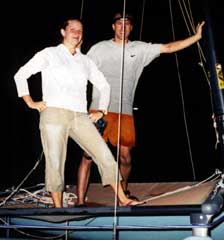Bird Island Resortcabana number one, part one |
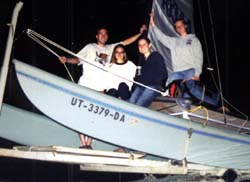 "I promised my
brother I'd come down and spend some time with him on Saturday," Chantal said,
"so I could camp Friday night or something." "I promised my
brother I'd come down and spend some time with him on Saturday," Chantal said,
"so I could camp Friday night or something.""Great," Shaun answered. "Try to bring your roommates and I'll gather some people down here."
Once at Lincoln Beach Marina, they read the instructions and fiddled with all the wires and ropes until they had everything figured out. This did not happen without slight mishaps, however, such as pulling the end of one line high into the air, far out of reach, with practically no way to retrieve it short of dropping the mast again. Fortunately, this wasn't mission impossible, but only mission difficult. Melissa stood on Shaun's shoulders as they both held the mast and the others steadied them. By reaching as high as possible with Shaun on tippy toes and swinging a bungy cord, Melissa was able to retrieve the line to hoist the main sail. "That's okay," we said for the first of many times that night, "more adventure this way." |
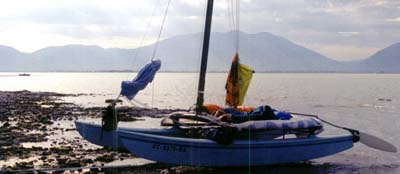 Soon they had lowered the boat into the water and tapped a bottle of
sparkling cider against the hull, christening it "Bird Island Resort Cabana Number
One." The fiberglass hull would not have withstood a full-on blow from the
bottle, and we'd never have reached Bird Island with a gaping hole in one pontoon. Soon they had lowered the boat into the water and tapped a bottle of
sparkling cider against the hull, christening it "Bird Island Resort Cabana Number
One." The fiberglass hull would not have withstood a full-on blow from the
bottle, and we'd never have reached Bird Island with a gaping hole in one pontoon.Reaching Bird Island was iffy anyway. We started down the channel sideways to the wind and were surprised how much more easily the catamaran steered than smaller, flat bottomed Lasers that Shaun was accustomed to sailing. Even with only the slightest breeze, the enormous sail sent us slipping quickly and gracefully through the water. Heading out into open water, we steered and tacked in the general direction of the island. "How big is the island?" Melissa asked. "In really high water, it's completely submerged. That's the only way I've ever seen it close up. At really low water, it's probably a couple hundred yards at the longest point. Right now, I'm guessing anywhere between fifty and two hundred feet long." After sailing back and forth for two hours, aligning the boat by the mountains and stars to stay in the general area where the island should lay, Chantal thought of calling Shaun's brother Antone to look up the GPS coordinates of the island, which weren't programmed into Shaun's GPS as he had thought when they left. "Nah, he'll be asleep already. Let's give it a while longer. I don't think we've missed it yet." We occassionally turned on our lights to look for land, watched in the bright reflection of the moon on the water or the dimmer city lights reflecting from the other direction, pushed the broken hockey sticks we had brought for pushing in shallows down to check the depth (most of the massive lake is only 15 feet deep), and listened for birds or waves breaking on the shore. This is the part that made the night a classic adventure. Not epic by any means, but wandering back and forth, semi-lost in the middle of such a huge, black expanse with bright stars twinkling high above the mast is worth remembering. "Is the island named for birds living on it?" Chantal asked. "No, it's because it's shaped like a bird. I never realized that till I flew over it once and looked down," Shaun answered.
With the lower water level, the island ended up appearing a bit sooner, and we turned the boat into the wind and slowed down just in time before scraping bottom as Melissa probed and warned of shallow water, then we pushed and lifted the boat to a secure place almost on shore. Just then, some of the island inhabitants heard us and hundreds of birds rose into the starry sky above the mast, squawking loudly in alarm. We rearranged our gear and soon settled in for the night, the deck accomodating four people perfectly. We hoped the birds would eventually settle back down, but had no such luck. We didn't get any true peace until we left the island the next morning. Maybe the island was named for the birds after all. |
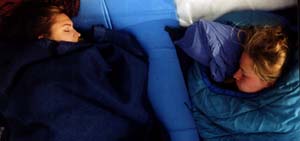 At sunrise, we all glanced up just long
enough to watch the clouds turn bright pink over the eastern horizon, then faded back to
dreamland for a few more hours. By the time we awoke again, ten other boats had
anchored off other sides of the island to fish. The island is nothing more than
barren, broken rock with some plant growth only on the highest ground. Waves from
frequent storms must scour the rest of the land. Not many years ago, half a dozen
tall trees grew there, but high water must have drown and killed them (or perhaps
by the storm that blew the lake so far south that it took four days for the water to drain
back off the land -- carp were found skewered four feet high on shattered willow branches
a mile inland and at least one boat's crew was killed, one of them found pounded by the
waves into the mud on shore). The replacement trees are currently four or five
feet tall. At sunrise, we all glanced up just long
enough to watch the clouds turn bright pink over the eastern horizon, then faded back to
dreamland for a few more hours. By the time we awoke again, ten other boats had
anchored off other sides of the island to fish. The island is nothing more than
barren, broken rock with some plant growth only on the highest ground. Waves from
frequent storms must scour the rest of the land. Not many years ago, half a dozen
tall trees grew there, but high water must have drown and killed them (or perhaps
by the storm that blew the lake so far south that it took four days for the water to drain
back off the land -- carp were found skewered four feet high on shattered willow branches
a mile inland and at least one boat's crew was killed, one of them found pounded by the
waves into the mud on shore). The replacement trees are currently four or five
feet tall. |
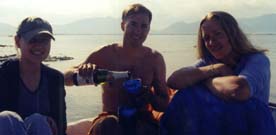 Once
up and after massages all around by Shaun (a Bird Island Resort specialty),
we drank the cider and toasted in the traditional High Adventure Coalition way to
adventure, passion, friends, nature and such; then ate our breakfast of bagels, cream
cheese, and yogurt. We then packed up, lashed down the bags, and dragged the boat
back out to deeper water. Once
up and after massages all around by Shaun (a Bird Island Resort specialty),
we drank the cider and toasted in the traditional High Adventure Coalition way to
adventure, passion, friends, nature and such; then ate our breakfast of bagels, cream
cheese, and yogurt. We then packed up, lashed down the bags, and dragged the boat
back out to deeper water. |
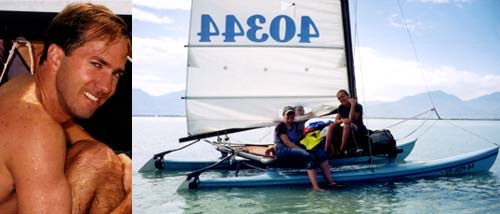 For most of the journey south to the harbor, the wind blew weakly and the
boat moved slowly but steadily. We couldn't have been happier since this allowed
time for pleasant conversations, cat naps, and getting to know each other better.
Everyone took turns at the rudders and Shaun couldn't quite talk anyone into swimming with
him. The lake is infamous for past pollution and many people still can't bring
themselves to trust their bodies to the murky depths...er, shallows. Once when a
gust came up, Shaun was left behind and the boat had to circle back and pick him up.
In the last few minutes, a solid (but you couldn't call it 'stiff') breeze came up and we
picked up to over ten miles per hour. Imagine what that boat will do in a real
wind!! For most of the journey south to the harbor, the wind blew weakly and the
boat moved slowly but steadily. We couldn't have been happier since this allowed
time for pleasant conversations, cat naps, and getting to know each other better.
Everyone took turns at the rudders and Shaun couldn't quite talk anyone into swimming with
him. The lake is infamous for past pollution and many people still can't bring
themselves to trust their bodies to the murky depths...er, shallows. Once when a
gust came up, Shaun was left behind and the boat had to circle back and pick him up.
In the last few minutes, a solid (but you couldn't call it 'stiff') breeze came up and we
picked up to over ten miles per hour. Imagine what that boat will do in a real
wind!! |
| part two... |
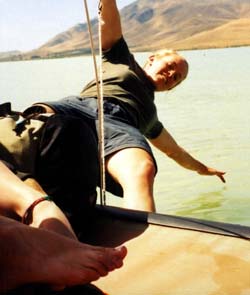 Shaun decided to resurrect an old goal to have at least one adventure per
week. Utah Lake cooperated when he launched the boat after dark again the following
weekend with Melissa and her sister Tiffany. The "real wind" I wondered
about...? Yeah. Read on. Shaun decided to resurrect an old goal to have at least one adventure per
week. Utah Lake cooperated when he launched the boat after dark again the following
weekend with Melissa and her sister Tiffany. The "real wind" I wondered
about...? Yeah. Read on.Time had grown too short to sail earlier in the day as planned, but another leisurely night cruise sounded nearly as good. "What's that smell?" Shaun asked as they raised the mast in the marina parking lot. The smell of rotting fish wafted up from the shore on a light south breeze. Any experienced sailor from this region of the west would recognize the danger warnings in the last paragraph. No, not the rotting fish. No, not the light breeze. The direction of the breeze is what ought to have clued Shaun in to the possibility that a front was approaching from the north west. South breezes are followed by a five-minute lull, and then the strong wind drops down from the northwest at the head of the front. Then again, with a few clouds overhead, the weather can rarely be predicted with certainty. "I need to get one of those watches with a barometer on it," he said hours later after the adventure had ended. Only the slightest breeze stirred as the boat made its way slowly down the channel...until fifty feet from the end. Then the north wind swooped down hard. The boat instantly picked up so much speed that Melissa asked "Are we going to make the corner?" Shaun wasn't sure how the boat would handle turning nearly directly into the wind, but the mouth was wide enough that they were able to make the final turn on a diagonal and maintain good speed while beating into the wind. After last week's mild sailing and tonight's initially soft breezes, we had decided to hoist the jib. As the waves grew to white capping swells, as the boat pitched up and over their crests and dove into the troughs, showering us with thick, warm spray, as we looked around into the moonless darkness, we decided the jib was overkill. Shaun steered into the wind to slow down for a milder ride while Melissa lowered the small front sail and Tiffany furled it. Once we had it clipped into a tight roll, it was time to get moving again. |
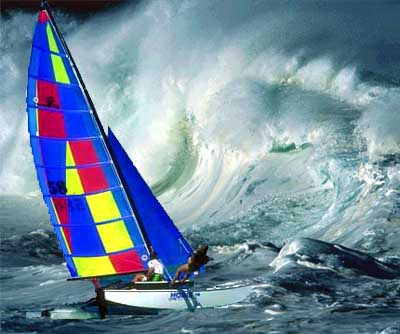 By this time, the waves had built to
nealry four foot swells. We listened in the dakness as white capping rollers came
roaring toward us. The girls, sitting on the front of the deck, frequently expected
Shaun to go underwater as the waves rolled under us because of the steep angle as they
looked back and down, but the pontoons lifted everything up and over each crest. As
beautiful as everything was, it was clearly time to get back to port. By this time, the waves had built to
nealry four foot swells. We listened in the dakness as white capping rollers came
roaring toward us. The girls, sitting on the front of the deck, frequently expected
Shaun to go underwater as the waves rolled under us because of the steep angle as they
looked back and down, but the pontoons lifted everything up and over each crest. As
beautiful as everything was, it was clearly time to get back to port.The trouble was turning around. Shaun got the boat moving sideways through the swells, building up speed for a turn by traveling sideways to the wind. At the top of a swell, he would quickly turn the rudders to spin the nose into the wind and come about to the other direction. But the next wave and the wind would instantly kill our speed and keep us from completing the turn. Shaun turned on his headlight and looked down at the rudders to realize we were actually moving backwards, the rudders sinking underwater and the front tips of each hull probably rising many feet in the air (the photo is totally fake, of course. We apologize for not taking any on this trip!). |
| Several times, Shaun considered jibing (turning
downwind), but this would mean a lot of wind pouring into the sails during the
turn and swinging the boom hard across the deck if he couldn't pull in the main sheet (the
rope controlling the sail's pitch) fast enough. We had also drifted nearer
to shore while lowering the jib and in the base of one trough, one rudder had touched
bottom. Better not to have too much speed with the possibility of running
aground. In daylight, he'd have tried it, but at night...better to play it safe.
(After reading up on sailing Hobie Cats, Shaun learned that the jib is all but essential
for coming about.) We finally managed to swing the nose around when the wind ebbed once, then headed quickly back toward the marina. Very quickly!!! This was the best part of the ride. The swells were easily four feet high now, after building for so many miles across the lake. Watching off the starboard beam, sailing roughly parallel to the waves, piles of white foam roared toward us as we slowly climbed and dropped over them. More white water shot out in a narrow line behind each pontoon as we sped along at around 30 mph, even with the sail let out wide to spill most of the wind's power. The spray that drenched us from time to time felt warm. Melissa got sea sick for the first time in her life. This went on for minutes as we watched the lights of the marina draw nearer. Whichever girl sat on the windward, higher side would look down at her sister and worry that she might fall off, though no one ever felt in danger of going overboard themself. (We should have placed everyone on the windward side. We were lucky the sail was all the way out - or a sudden gust could have capsized us.) Finally we decided we were close enough. We nosed the boat
into the wind again and quickly dropped the main sail, then drifted in to shore to avoid
running aground with any speed. We ended up missing the slot of the channel by a
hundred feet, but this turned out for the best. The boat finally touched bottom
fifty feet from dry ground and Shaun and Melissa pulled it in closer. Friendly
campers on shore who had watched us put out and come in drove a four wheeler out to the
boat to pick up Melissa and give her a ride to her truck. She backed the trailer at
least fifty feet into the lake where we lifted the front of the boat onto the rollers,
then pushed the rest onto the trailer. This was easier than loading it in the wind
on the deeper boat ramp. Hugs and high fives followed once we had pulled back up to the parking lot to lower the mast and secure everything for the drive home. Was it irresponsible to get caught on the lake at night in that kind of storm? Ummm...well, we sailed conservatively and while the boat may have been damaged if we had run onto rocks, we kept things well under control. One benefit, perhaps, of sailing with a tall mast on Utah Lake is that if the boat turtles, it can't float straight upside down. The mast will drag and spin the boat downwind, making it that much easier to right. (WRONG!!! The mast will jam into the mud and the waves will pound it in deeper and deeper and perhaps the only way to get it out is to get the wind and waves to spin the boat around and tear itself loose. Get an anti-turtling device to keep the end of the mast afloat! Oh, we were lucky, so naive in those early days with the Cabana.) This comment by fellow sailor Samuel expresses a bit of the spirit of adventure tied to sailing and the reason to go out on the water: "When your hull is flying and all the wires are humming and you and crew has moved back as far as you can go and the hull is barely out of the water, Ha! You are sailing the razor's edge. Only someone that has been there would know what I am saying." |
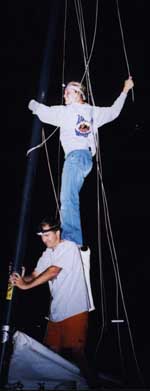 "Where will we go?" Chantal asked, and Shaun began listing
options. When he mentioned "Sail to Bird Island and camp," the questions
stopped. "That sounds perfect." Shaun found a 16' Hobie Cat for sale
online, bought it, and they left his place for Utah Lake after the last of the four
adventurers showed up slightly after sunset. Chantal brought Melissa and introduced
her to Shaun (though it turns out they had met a year earlier in an EMT course)
and to Nathalie, who had just flown in from Switzerland earlier in the week.
"Where will we go?" Chantal asked, and Shaun began listing
options. When he mentioned "Sail to Bird Island and camp," the questions
stopped. "That sounds perfect." Shaun found a 16' Hobie Cat for sale
online, bought it, and they left his place for Utah Lake after the last of the four
adventurers showed up slightly after sunset. Chantal brought Melissa and introduced
her to Shaun (though it turns out they had met a year earlier in an EMT course)
and to Nathalie, who had just flown in from Switzerland earlier in the week. 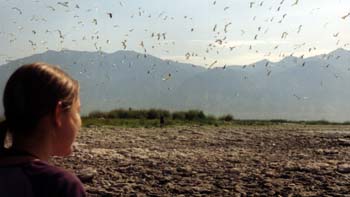 By 2:15 a.m., we changed our mind about the value of
Antone's sleep and made the call. "Hey Antonio. We're out in the middle
of Utah Lake and were wondering if you could get us the GPS coordinates for Bird
Island." He called back a few minutes later and when we had plugged in the
numbers, found that the island was only .8 mile away, in same course we had been
searching.
By 2:15 a.m., we changed our mind about the value of
Antone's sleep and made the call. "Hey Antonio. We're out in the middle
of Utah Lake and were wondering if you could get us the GPS coordinates for Bird
Island." He called back a few minutes later and when we had plugged in the
numbers, found that the island was only .8 mile away, in same course we had been
searching. 